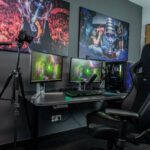Gamers at every level have a pivotal decision when choosing what hardware to use. The difference between victory and defeat can be an issue of mouse sensitivity settings or simply dragging your video game controller with enough force. To enjoy the new first-person shooter games, sports, and racing more than if they were on a TV screen, you will need both a powerful PC with a graphics card and also an HD monitor that will take care of various motion artefacts.
Games monitors are a necessary gaming component, but there are many factors to consider. They should guide your decision when choosing one. In this article, we will help you select a monitor with excellent video quality that will allow you to play games without lag.
Size of the Panel and the Resolution
Of course, bigger is not always better. Many gaming monitors make up for their smaller size by being cheaper or offering a sharper image. Sometimes, you will want to keep the monitor size at 27 inches or fewer. If you are an e-gaming die-hard fan, you might have noticed during the big tournaments that the players compete on screens smaller than the size mentioned above. A 24-inch display is a sweet spot for those who want to play e-sports games such as Asus ROG Swift 360Hz PG259QN.
In games with a smaller play area like Counter-Strike: Global Offensive or League of Legends, the screen size does not affect the players’ ability to track what is going on as you can keep the monitor closer to your eyes while still keeping more of the frame in a close view.

It is helpful to see every element on the screen simultaneously, which becomes more complex as a player’s screen size increases. Most players find it challenging to keep track of enemies they cannot see outright.
The Panel Technology
To understand the pros and cons of various gaming monitors in the market, it’s essential to know about the three kinds of technologies they use. We explain below.
- Twisted Nematic (TN),
The panels offer fast pixel response times and refresh rates, making them the most affordable option for gamers. One major disadvantage of the polarized lens is that they shift colours when viewed from an angle.
- Vertical Alignment (VA)
They have praised VA panels for delivering deep blacks and vibrant colours. However, they can also produce a visible motion blur that affects gaming performance. However, different models will have separate utilities, and that is precisely where reviews come in. So, do thorough research before making your decision.
- In-plane switching (IPS)
IPS panels give the best overall colour quality, excellent grey-scale performance, and wide viewing angles at the expense of a slower response time. However, they cannot match the pixel response of TN panels and will suffer from motion artefacts.
IPS panels are the best general-use display type, but those looking for more features can sometimes be dissatisfied.
Each TN, VA, and IPS technology has its distinct traits, so it is best to look at samples of each, if possible. It would help if you also kept in mind that not every panel is of the same quality. Viewing the display before making your decision will give you an idea of which compromises are worthless. This way, you can make a more informed decision about what suits your needs best.
Pixel Response, Input Lag, and Refresh Rate
Gaming monitors should have a fast pixel response time and a high refresh rate to achieve the most fluid gaming experience. The most commonly used measurement is the speed at which pixels change from one grey shade to another in milliseconds. A low pixel response will help eliminate the smearing of moving images. This reduces flicker and provides a smoother overall picture than a higher pixel response. A grey-to-grey response of 2ms or less is ideal, but even a 4ms grey-to-grey response is typically adequate for gaming.
Also, consider the input lag when buying the next monitor for gaming, especially if you’re an avid gamer. Input lag is the time it takes for your action to register on the screen. Several gaming monitors using the HD Fury 4K Diva have been tested. Experts have found that monitors under 5ms are great for people with quick reflexes who like to be the best opponents.
Lastly, we look at the refresh rate of the monitor. The refresh rate of a monitor refers to the speed at which it refreshes. The higher the rate, the more frames per second that can be displayed on-screen and, therefore, smoother motion. Most LCD monitors and gaming panels have a maximum refresh rate of 60Hz. This means that the screen is refreshed 60 times per second. Fast-moving images may appear less clear and may suffer from tearing artefacts that can be messy on some screens.
G-Sync and FreeSync: Technologies Standard in Flux
Gaming monitors use synchronization technology to reduce tearing and input lag while keeping motion artefacts down. Displays with Nvidia’s G-Sync or AMD’s Free-Sync technology have a hand-off control of the screen refresh rate on their graphics card. This is called the variable refresh rate (VRR). It allows displays to operate at a VRR according to what the card can push. The result is an improved game experience, with decreased input lag and reduced tearing rate. However, the G-Sync and Free-Sync monitors require that the graphics card has a Display Port 1.2 or HDMI 2.0 output.
HDR: With Brightness
HDR technology not only makes movies and TV shows look good, but it also brings games to life for those who prefer to play in dark surroundings. There are four HDR levels on monitors with DisplayHDR- 400, 600, 1000, and 1600. The figures refer to how bright the display should be. Although there are plenty of HDR 4K monitors to choose from these days, implementing HDR within Windows remains unimaginable. Also, Windows 10’s HDR compatibility extends to apps and the OS itself.
Video Inputs and Other Features
Gaming monitors should have as many inputs for video connections as possible. This is because it is common for gamers to play on multiple PCs and consoles. When gaming, it is beneficial to have two different ports available. DVI was once the standard for computer monitors. More recent connections only include the HDMI.
The Acer Nitro XV3 has a display port 1.4b that will only work with two cables plugged in simultaneously. This is the first model we have seen that does so.
USB ports make it easy to connect various peripherals, charge your devices, and easily trade data. Attaching a USB device can be difficult if you do not have access to the back of the monitor. The speakers on a desktop are suitable for gaming and offer comfort with adjustments, but a separate external Woofer will be more powerful. If you game with specialized gaming headphones instead of built-in speakers, a conveniently situated USB port might be more important to you than mediocre speakers.


